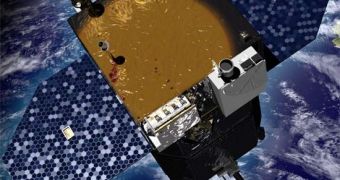Experts waited for the entire duration of the launch window yesterday, before finally calling it a day. NASA's new observatory, the SDO, was supposed to take off from the Cape Canaveral Air Force Station (CCAFS) at around 10:30 am EST (1530 GMT), but high-speed winds in excess of 30 knots prevented this from happening. In order for the launch to be a go, winds must not exceed 20 knots at the pad. Another launch attempt has been scheduled by officials at the space agency to Thursday, at 10:23 am EST (1523 GMT). For today, there is a 60-percent chance of good weather in Florida, as opposed to the 30-percent chance the Weather Office recorded yesterday, Space reports.
The Solar Dynamics Observatory mission took more than $850 million to set up, and it is aimed at studying the variability of the Sun, especially in extreme ultraviolet wavelengths. The craft is scheduled to remain in orbit for more than five years, but it has enough propellant to endure for ten. Mission controllers hope that they will be able to secure the funding required to operate the spacecraft for as long as possible.
“The weather has not been kind so far to SDO,” the weather officer for the new launch, US Air Force Major Christopher Lovett, explained yesterday. “SDO is the most advanced spacecraft of its type ever designed and flown,” the NASA Science Mission Directorate Deputy Associate Administrator for Programs, Michael Luther, said of the observatory. “We're all very excited about finally getting SDO up in the sky where it needs to be,” the principal investigator of the SDO HMI instrument, Stanford University scientist Phil Scherrer, added.
Arguably the most important tool aboard is the Extreme Ultraviolet Variability Experiment (EVE), which will be in charge of measuring precisely how much radiant energy the Sun emits at extreme ultraviolet wavelengths. Such measurements cannot be documented from our planet because the atmosphere traps these wavelengths, and does not allow for this kind of light to pass. On the other hand, people living in space, such as astronauts on the International Space Station (ISS), are exposed to the effects of EUV light around the clock.
The other two instruments, the Helioseismic and Magnetic Imager (HMI) and the Atmospheric Imaging Assembly (AIA), will work together in order to create correlations between variations that occur on the Sun's surface and within the star. It will be HMI's job to create maps that will explain the plasma flows that occur underneath the solar atmosphere, as well as to determine the surface of the magnetic fields at work. AIA will, in turn, take measurements of the solar atmosphere in wavelengths that are not available from Earth.
“SDO will take full-disk, high definition images of the Sun all of the time. These advances will provide the data to better understand how the Sun works and will allow us to develop the tools to predict its behavior,” Liz Citrin, who is the SDO project manager at the NASA Goddard Space Flight Center, in Greenbelt, Maryland, concluded.

 14 DAY TRIAL //
14 DAY TRIAL //